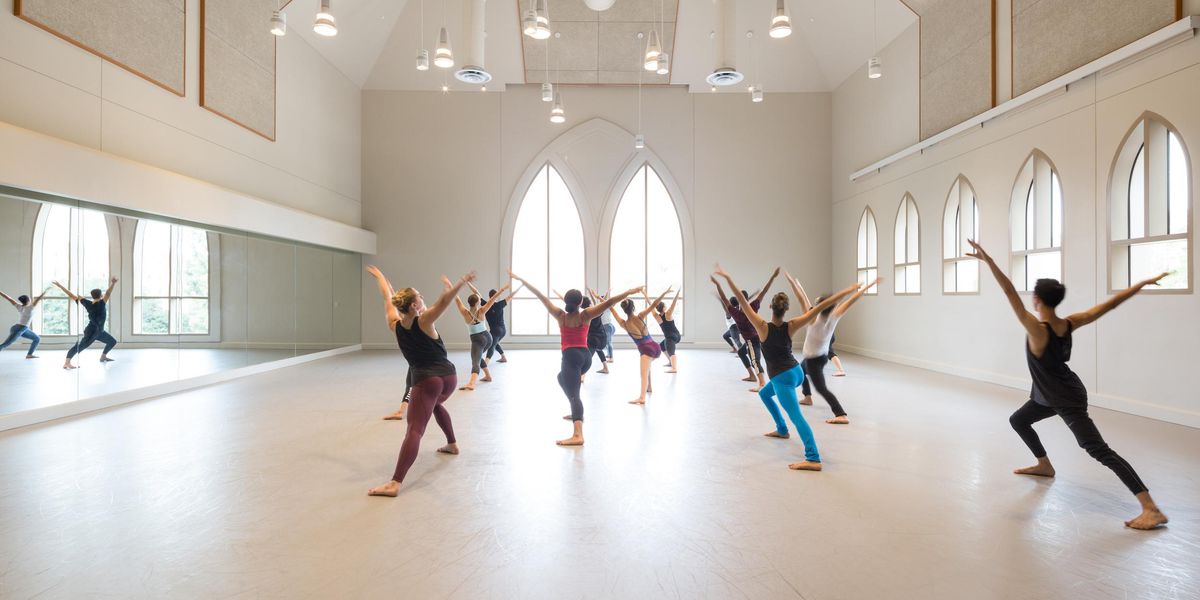Technique My Way: Laurel Tentindo
Tentindo in Trisha Brown’s
Raft Piece. Photo by Carrie J. Brown, Courtesy Trisha Brown Company.
Trisha Brown Dance Company’s Laurel Tentindo is a study in fluid energy. In a recent rehearsal for Brown’s Set and Reset, the lean redhead sliced across space with blade hands rebounding against the air, the aftershock reverberating up her pliable spine. Even standing still, she appears to move in minuscule vibrations. Turns out, this is no mistake. “I don’t think of the body as bones and blood,” she says. “I think we’re strange water, fluid, fascia balloons moving in space. If we can always find spaciousness in our tissues, from the top of our spine to our heels, we have more freedom to move.” DM chatted with Tentindo, who has been with TBDC since 2007, to find out how she maintains the healthy mind-body balance that informs her dancing and well-being.
Spiraling Into Motion
Growing up in Essex Junction, Vermont, Tentindo studied ballet and non-traditional theater. Instructors from Les Grands Ballets Canadiens de Montréal who taught at a local studio, The Movement Center, gave her the unadorned classicism that, along with improvisational skills learned in drama classes, serves as the basis for her technique.
While Tentindo appreciated this early ballet training, the expectations it created were extreme. “The box was too narrow,” she says, “so much so that I developed an eating disorder. I felt sad, spiritually.” When she found contemporary dance, late in high school and then at Sarah Lawrence College, “I felt free. My aesthetic changed. I realized I love the practice, the ritual, the spiritual component of dance more than formal rules. I got to heal.”
Then Tentindo encountered what became a cornerstone of her training and health maintenance, Skinner Releasing Technique. During college, she took Skinner classes each summer in Seattle; she later studied for five years to become an instructor. “Skinner Releasing integrates technical practice with the imagination,” she says. “Hands-on work and imagery of the spine and skull allow you to free the limbs. The tone of the class is safe and supportive and the word ‘allow’ is primary.”
Every morning, Tentindo applies these principles as she takes time to “check in with my energy and spirals,” she says, referring to spiraling the muscles around the spine in opposite directions. “Perhaps I’ll stretch in my bed or on the floor, completing the simple spiral of shifting my bent knees to one side and looking to the other side. I might also put my legs up on the wall, letting the femur drop back, and feel the weight in my body as I breathe. Then, if I’m heading to the studio, I tailor my warm-up to what I’ve found in that initial investigation. I begin by slowly breathing and softening in different areas to practice releasing.” From there, Tentindo might do a modified version of the “spiral series” that she learned from anatomy and kinesiology expert Irene Dowd. “The basis is flexing and extending the major muscles while spiraling.” Then, either standing or lying down, she works in “continuous, multi-directional alignment, traveling through space,” which might manifest in arm swings, tendus, or dégagés.
Beyond Release
Dancing for Trisha Brown isn’t all about letting go. “Even though we do so much release work, you can’t flop around. You’ll hurt yourself,” Tentindo says. “You need to engage and draw in the abdomen, back, and sides to protect your body.”
Throughout rehearsal, Tentindo often checks in with her feet because “that’s where the weight should be.” At times, she concentrates on switching “into a tai chi state,” she says. “When I’m first seeing a phrase, I’ve learned to mark, using initiation points but not ripping into it immediately. Knowing how to modulate the volume on your output as you go through rehearsal, softening sometimes and popping at others, is so important for longevity.” She completes her routine on rehearsal days by icing andelevating her legs.
On days without dance, Tentindo keeps her body awake by simply “moving through space,” she says, whether biking, swimming, or walking in the park. “Dancing in Trisha Brown gives you the gift that you’re always in your body, always aware, even if not onstage.”
Tasty Nutrition
Of her teenage eating disorder, Tentindo says, “I was eating, but in a way that I was always losing weight. It was destructive as it happened when I was still growing. I reached a point when I couldn’t sustain those eating patterns.” Recognizing her problem, she consulted a college advisor, who directed her to a support group. “The group allowed me to realize the emotions that were creating the disorder, and I learned how to taste and enjoy eating.”
Now, Tentindo approaches nutrition in the same holistic way she dances. “I choose delicious, nourishing foods so that when I eat it’s fully satiating,” she says. “I also find that the food you cook, or that someone you love cooks for you, is best.” While Tentindo doesn’t rule out many options (“Sometimes you need dessert and sometimes you don’t!”), she steers clear of hydrogenated oil and high-fructose corn syrup. Breakfast is a must. “You have to eat in the morning,” she says, “to stabilize your blood sugar for the entire day.”
Get a Life
Having a full life outside the studio is crucial for Tentindo. She enjoys doing film and puppetry projects with her husband, former dancer and puppeteer Luis Tentindo. “The more fun I’m having being creative in my whole life, the more I’m able to feel in the studio. And being creative in your overall life allows you to drop the idea that there is something perfect. You need to gain nourishment from outside of the studio to give dance what it deserves.”
Lauren Kay, a
Dance Spirit contributing editor, is a dancer and writer in NYC.




